As the demand for energy continues to rise, the importance of ensuring the safety and security of intrastate pipelines cannot be overstated. These pipelines play a crucial role in transporting oil, natural gas, and other hazardous materials across vast distances, making them susceptible to various risks such as leaks, corrosion, and external interference. However, recent advancements in technology have paved the way for innovative solutions to enhance the monitoring and safety of intrastate pipelines, ultimately securing their future and the communities they serve.
The Importance of Pipeline Safety
Ensuring the safety of intrastate pipelines is essential for a variety of reasons, including:
- Protecting the environment from potential leaks and spills
- Safeguarding the surrounding communities from accidents and explosions
- Maintaining the integrity of the pipeline infrastructure
- Complying with regulatory requirements and industry standards
Risks Associated with Intrastate Pipelines
Several risks are associated with intrastate pipelines, which can compromise their safety and integrity:
- Corrosion: Over time, pipelines can degrade due to corrosion, leading to leaks and ruptures.
- Third-Party Damage: Excavation activities near pipelines can result in accidental damage and breaches.
- Natural Disasters: Events such as earthquakes, landslides, and floods can pose threats to pipeline infrastructure.
- Terrorism and Sabotage: Deliberate acts of sabotage or terrorism can target pipelines, causing widespread damage.
Technological Innovations in Pipeline Safety
Advancements in technology have revolutionized the way intrastate pipelines are monitored and maintained. Some of the notable innovations include:
1. Drone Inspection
Utilizing drones equipped with high-resolution cameras and sensors to conduct aerial inspections of pipelines, allowing for early detection of potential issues such as leaks, encroachments, and corrosion.
2. Real-Time Monitoring Systems
Implementing real-time monitoring systems that use sensors and data analytics to continuously assess the condition of pipelines and detect anomalies such as pressure fluctuations or temperature variations.
3. Leak Detection Technologies
Employing advanced leak detection technologies, including acoustic sensors, infrared cameras, and fiber optic cables, to promptly identify and locate any leaks along the pipeline.
4. Cathodic Protection
Deploying cathodic protection systems that use electrical currents to prevent corrosion and extend the lifespan of pipelines, reducing the risk of leaks and structural failures.
Regulatory Framework and Compliance
Ensuring the safety of intrastate pipelines also requires a robust regulatory framework and a culture of compliance within the industry. Key aspects of regulatory oversight include:
Pipeline Safety Regulations
- The Pipeline and Hazardous Materials Safety Administration (PHMSA) establishes and enforces regulations to ensure the safe operation of pipelines.
- Compliance with standards such as API 1160 and API 1173 is essential to maintaining the integrity of pipeline systems.
Industry Best Practices
- Following industry best practices and guidelines for pipeline design, construction, operation, and maintenance is critical to preventing accidents and ensuring safety.
- Regular inspections, integrity assessments, and emergency response drills are essential components of a proactive safety culture.
Collaboration and Knowledge Sharing
Promoting collaboration and knowledge sharing among industry stakeholders, including pipeline operators, technology providers, regulators, and communities, is vital for enhancing the safety and integrity of intrastate pipelines.
Industry Forums and Workshops
Organizing industry forums, workshops, and training sessions to facilitate dialogue, exchange best practices, and foster innovation in pipeline safety and monitoring.
Public Awareness Campaigns
Engaging with the public through awareness campaigns, community outreach programs, and transparency initiatives to build trust and promote safety culture around intrastate pipelines.
Conclusion
Securing the future of intrastate pipelines requires a multi-faceted approach that combines technological innovation, regulatory oversight, industry best practices, and collaborative efforts. By leveraging the latest advancements in safety and monitoring technologies, enhancing regulatory compliance, and fostering a culture of safety and transparency, the industry can mitigate risks, prevent incidents, and ensure the continued reliability of intrastate pipeline infrastructure for years to come.
